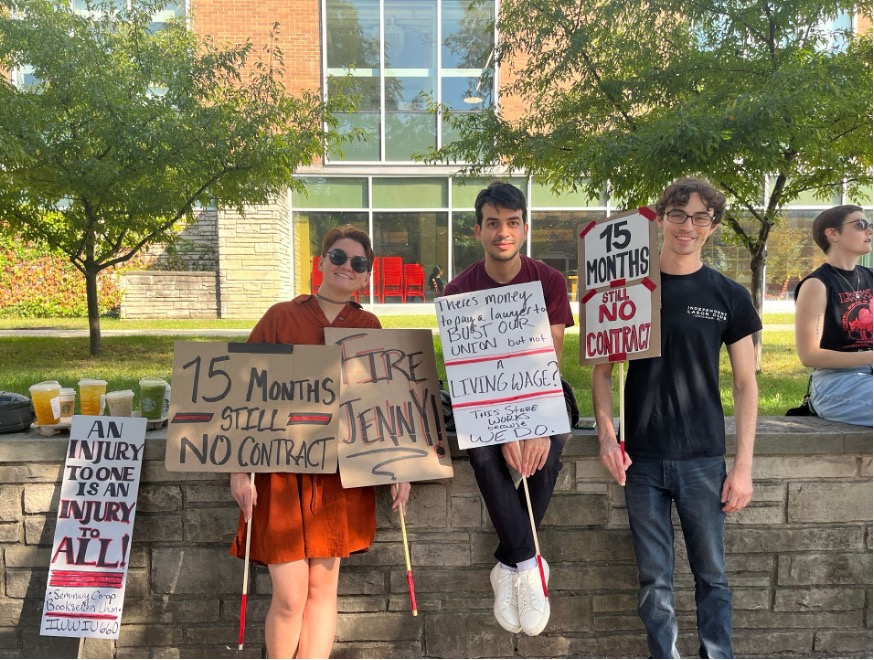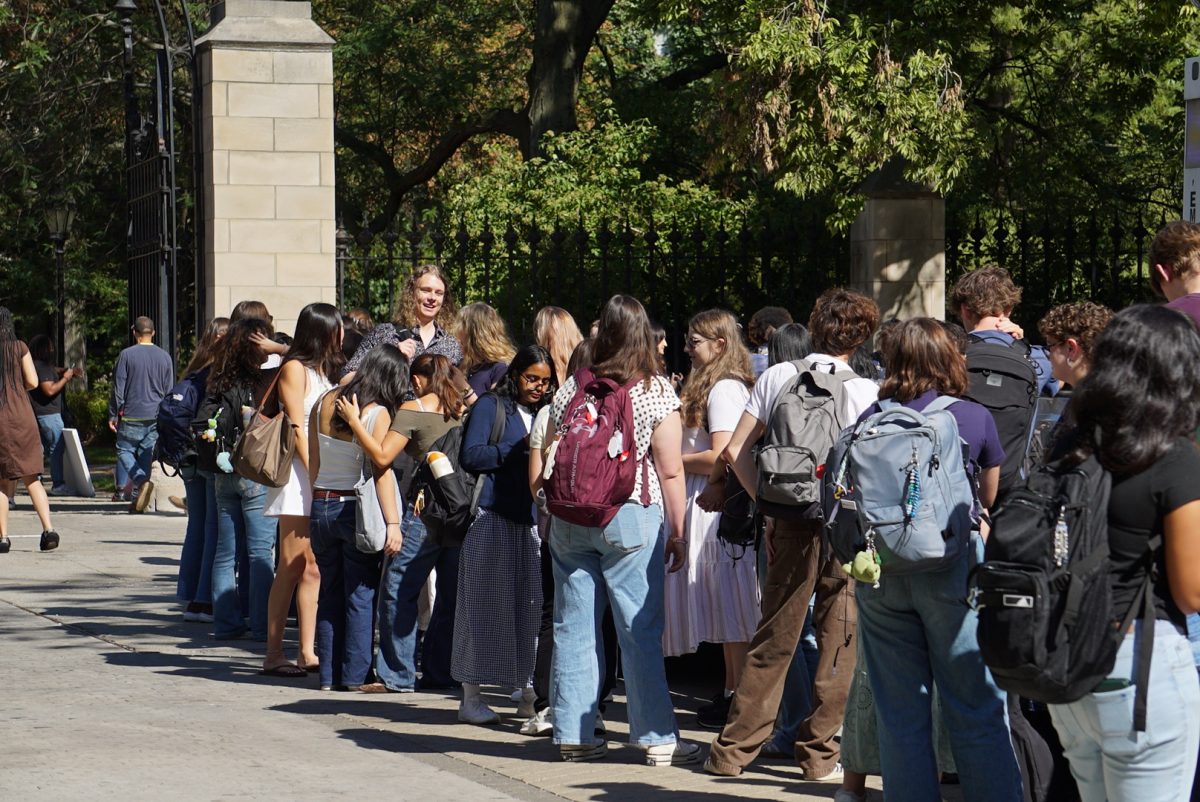Amir Sufi, professor of finance at the University of Chicago Booth School of Business, recently published a book entitled *House of Debt*, which he wrote with Princeton economist Atif Mian. In this book, Sufi and Mian attempted to clarify the causes of the Great Recession and provide solutions to many of America’s current macroeconomic issues. Sufi’s research has been profiled by The Economist, The New York Times, and The Wall Street Journal. The Maroon sat down with Sufi to talk about his work, the recession, and current American economy.
Chicago Maroon: Could you give a brief overview of your career as an economist?
Amir Sufi: I started here in 2005 as an assistant professor, so I guess I have been here almost nine years. I got my Ph.D. in economics from MIT, so I’m an economist. I’m in the finance group. My coauthor was here my first three or four years, then went to Berkeley and then Princeton. I teach corporate finance. I just started teaching cases in financial management that have a focus on restructuring and corporate governance, and that is what I am teaching next year as well.
CM: How did you get your interest in finance from your Ph.D. in economics?
AS: Before I did my Ph.D. at MIT, I worked as a research assistant at the Federal Reserve Bank in New York. I’ve always had a strong interest in the intersection of macroeconomics and finance, and in particular banking. In fact, my [Ph.D.] thesis was on banking. So, I kind of consider finance to fit within the broader field of economics. We have a finance department at Booth in which most are economists or think like economists. Especially since the Great Recession, there has been a renewed interest in economists across all fields in finance. Of course, with Gene Fama winning the Nobel Prize in economics, it tells you that finance is squarely considered within that field.
CM: Where did your inspiration come from in trying to understand why the recession occurred and potential solutions that could address gaps in our understanding of the issue?
AS: So I think it started off as research in the traditional sense that my coauthor and I were talking about interesting issues in 2005, 2006 when I first started. One of the striking features of the research in the housing wealth effect was that it was very small. That people don’t spend much more when their home values go up. We simply thought that couldn’t be right in this huge housing boom. Both of us had an intuition that this housing boom was driving spending to a large degree, particularly among lower-credit-score, lower-income individuals. So, it started off with that very narrow focus of trying to estimate how that housing boom was contributing to household spending. Interestingly enough, as we started getting further into the project, we realized how dangerous the expansion of sub-prime mortgages had been. I remember we were looking at the data in early 2007 and we started to see default rates on these sub-prime neighborhoods go up sharply, and this was well before the financial crisis. We already were saying this was a striking feature of the data, and this is where the process started. And, it just got sequentially bigger in terms of our focus as the economy was collapsing, because it was in these same neighborhoods where credit was expending that spending was declining rapidly. And then of course, Atif had a focus in his previous research on merging markets, so he had seen this dynamic in other countries. There is a joke running around in the profession that Atif was a merging market economist, and then started focusing on the US when it became a merging market. I think there’s some truth to that. And then I think once we sat down and started to realize what was happening in Europe and the United States, we started doing research on the Great Depression, on the Panic of 1819, and other economies. And we started seeing this pattern of rising household debt and recessions to follow.
CM: When talking about the Great Recession, a lot of economists have focused their research on the banking system’s failure, rather than consumer expenditures and household debt. How do you see the banking system contributing to this problem, if at all?
AS: I think there has been too narrow a focus on the banking crisis aspect of what I would call more broadly a financial crisis. In my view, a financial crisis is the result of two distinct patterns. One is a tremendous rise in private debt burdens. So, by private debt I mean household debt and debt to non-financial corporations. Oftentimes that becomes unsustainable, and then leads to a banking crisis, because people start to default on that debt. I think that Reinhart and Rogoff, the experts of financial crises, they have found that all great financial crises are preceded by large run-ups in household debt. You have this dynamic where it’s clear that both of these factors matter. We’re not trying to say that the banking crisis is irrelevant. It clearly leads to financial panics, but I think that you have to recognize both of these aspects. In my view, the private debt is what drives the initial parts of the recession. It can get amplified when the banking crisis hits, and I think there is a strong role for policy makers, especially those in the central bank, to arrest that financial crisis by protecting the payment system. But I think where people have gone wrong, and I think this was a major reason for our reason to write the book, is that people have become so singularly focused on the banking crisis as the cause of the downturn, and the evidence does not support that. I think now we understand that. There’s no way we could’ve have gotten this severe economic downturn that has lasted this long. We’re still way off-trend in terms of where we are in terms of the growth of the U.S. economy, whereas the banking sector has been healthy since the middle of 2009. So, we’re talking five years. The banking sector has been healthy for five years, whereas the economy is still unhealthy.
CM: I think a primary reason for why household debt increased so much in the late ‘90s and early 2000s was due to the incentives the Clinton administration set for increased homeownership and borrowing. Could you talk about the monetary and fiscal policy that influenced the crisis?
AS: I think there was a toxic mix of bad incentives on the side of lenders giving credit to people who could not pay those mortgages for a couple of years. We make the argument in our book that the advent of private label securitization or sub-prime securities was something that came out of the private sector, rather than something that was induced strongly by the government. That being said, there is pretty good evidence that as we got into 2005 and 2006, there was Fannie Mae and Freddie Mac buying some of these mortgage-backed securities. So, it is very hard to pin the beginning of private label securitization on Fannie and Freddie, but they had to do something with what happened in late ’05-’06. The way I often explain it is the party got started with Fannie and Freddie not being there, and it was probably already getting out of control until midnight. And then after midnight Fannie Mae and Freddie Mac shows up, and most of us know very few good things happen after midnight, so there is kind of an amplification effect that you get from the government. But if you look at why Fannie and Freddie got into the sub-prime space, I don’t believe it was because the policy makers wanted them to lend to lower income individuals. Instead, they were acting the way a government-subsidized institution would do if they had liabilities guaranteed by the government—you want to take a lot of risk with your assets. It was standard risk-shifting.
CM: How do you think moral hazard fits into this, and how can we prevent this in the future?
AS: So, I think that in terms of preventing it in the future, we look to the advice and history of Charles Kindleberger, and what he has been saying of why financial crises happen. In fact, you see a lot of commentators making the same point that financial crises are always preceded by someone convincing investors that what they are holding is super safe, that it won’t have any losses. My colleague Robert Vishny has done a lot of research on this, what he calls neglected risks: trying to convince people what they are holding is super safe and then loading up on that risk, essentially, that they are ignoring. In the long run, what we are trying to propose is a more equity-centric world where people understand that they are taking risk. We understand that when people take risk they demand a higher return, and that’s completely fine, and that’s the way the world should work. I think right now the government subsidizes so massively the use of debt by the household sector, banks, intermediaries, and it’s so pervasive. There are obvious things like the mortgage interest deduction, but there’s also, like, when they regulate banks and say to banks that they can only hold super safe assets, which means they have to issue debt. I have this strong belief that if you got the government out of the financial system, at least in regards to the subsidization of debt, the world would look more equity-like. I always give the example of venture capital, private equity.
CM: So, do you think that the Obama administration should not have gotten involved in the recession by injecting $787 billion into the economy through the American Recovery and Reinvestment Act of 2009?
AS: I think that we’re pretty clear in the book about the distinction that we would make between protecting the payment system and guaranteeing short term claims in the banking sector to try to prevent runs. So for example, we’re very complimentary of the efforts of Mr. Geithner in 2008, when he was still at the New York Fed, of guaranteeing all money market funds. Now, you could imagine that’s an enormous incentive for moral hazard, but it was necessary to stop that run. Where we have a problem with the Obama administration, and preceding that with the Bush administration, with the TARP [Troubled Asset Relief Program] bill itself is the notion that we should protect equity holders and long-term creditors in banks. Banks’ capital structure has a lot of short-term debt claims like deposits and has longer-term debt in equity. The traditional prescription of trying to stop bank runs does not say you have to protect equity holders in banks, people lose money every day in the stock market. We think they had a very singular focus on banks in the sense that they were willing to go beyond the payment system and subsidize equity holders and longer-term creditors. On the flip side, because they had this focus on equity holders and creditors, they were unwilling to consider policy that would have led to further write-downs and mortgage debt. It was that asymmetry that was ill-advised. We needed a more even-handed approach: stop the financial panic, but at the same time think of policy that would facilitate the write-down of mortgage debt, which we think was necessary.
CM: Could you explain more about mortgage write-downs and policy related to that?
AS: So our view is very simple. House prices have crashed. These debt claims are no longer solvent, because homeowners are underwater. There are real losses that need to be borne, but the question is: Who bears them? In one view of the world, the debtor bears the loss, and when everything goes underwater they lose more than they put in, and that’s pretty much what happened. We imposed massive losses on debtors. What we’re saying is that we needed policy that allowed for a more even distribution of these losses. Debtors took a loss, but creditors should have taken a loss. For example, the proposal to allow bankruptcy judges to write down mortgage debt. Right now, the way bankruptcy law works is that bankruptcy judges are allowed to write down any debt if you file for bankruptcy but not your first mortgage on your home. And there has been strong policy support to allow bankruptcy judges to cram down mortgages. The point is, you need that threat to bring the lender to the table to renegotiate. There were proposals that were along the lines of establishing institutions that would facilitate renegotiations of mortgages, because securitization made mortgages very difficult. There was almost no effort on these dimensions. Most of the members of the Obama administration, *ex post*, have said they wish they pushed for more mortgage cram-downs. Most of them recognize that this was a shortcoming in their policy decisions.
CM: How do you think the financial landscape would look if debtors and creditors bear this even burden of mortgage losses in the short run and long run?
AS: That’s the ultimate rethinking of the financial system that we are proposing in the book. Let’s think about a world in which investors and homeowners have an equal sharing of risk. I think it’s important to emphasize that it’s not just about the downside, but also about the upside. The proposals we have in mind would give investors upside if your house appreciates and you sell your home, then they would get 5 percent of the capital gain. Likewise, one of the proposals we have in the book is that when you refinance your home, the bank gets 5 percent of the gain. So that would disincentivize you from doing aggressive borrowing with your home, because you will have to hand over some cash. We think all of these things would be better automatic stabilizers to make the housing market much less volatile. You wouldn’t see nearly as big booms, because lenders would understand that they are bearing risk. Likewise, when housing prices crash, the losses wouldn’t be borne just by borrowers – potential homeowners, so you wouldn’t see such large crashes in the housing market.
CM: What other macroeconomic research on the recession is out there, and what is your reaction to such theory?
AS: In my view, the most compelling complementary view is that there were longer run problems in the economy, for example the decline in manufacturing employment and the lower labor force participation of males, young males especially, people with less than a high school education, and this argument basically says that the housing boom hid these problems. The reason why the recession was so harsh is because in some sense there was a longer trend already in place. This is also closely related to the arguments that Larry Summers has been giving on secular stagnation, the idea that the only way we have been able to keep up with trend growth is due to the artificial tech boom which boosted investment, artificial housing boom which boosted consumption, etc. This idea to us has some power, and we are thinking a little bit more about that now.
CM: Now, there has been all of this talk about the reinvention of macroeconomic theory. Do you think that the other side of the fence, microeconomic theory, needs to be addressed in the future?
AS: I think that microeconomic theory and price theory has tremendous power. I think that we should never move too far away from the power of what microeconomic theory can accomplish. The way I approach the world is that I look at the benchmark models of the way microeconomics works, and then only when I see a substantial amount of evidence that microeconomic theory is wrong then I look for alternatives. One of the largest drawbacks of the traditional microeconomic rational behavior model is the borrowing and spending behavior we’re seeing among the lower half of the income distribution. What I mean by that is that there is a large fraction of the income distribution that will spend when given credit even when that’s not in their best interest in the long run. I think that there has been a lot of research on this, and this is where behavioral economics has the most potential in thinking about the irrational behavior of people with low credit scores. It doesn’t seem like they are behaving according to the rational model. Most are behaving like they have good income prospects in the future, when it is not necessarily the case. So that’s been where a lot of our research is focused.
CM: With all of this said, how do you see the next recession arising, and how can we address the issues that it may present even before it happens?
AS: I don’t know where the next recession will come from specifically. But, the longer-run issue we are pointing to is a dangerous, unstable system that is very related to wealth inequality. One of the big points that we are making in this book is that when you have a very unequal wealth distribution, the poor are borrowing from the rich, essentially. We call it banking, but the rich ultimately own the claims in the bank, and then the banks are lending to the poor. We are seeing a similar dynamic right now with credit card origination, and sub-prime auto loans. We are seeing a pretty large growth in these markets. I don’t mean to send off a fire alarm that this system is going to crash, but it is worrisome, unless we see fundamental income growth in the lower part of the income distribution. In some sense, they are borrowing against money they don’t have. One of the things that worries us in terms of the stability of the overall macro economy is when you have a wider distribution of wealth, and you have debt in that mix, it will naturally lead to spending volatility. Anytime the banking sector decides to lend more to the poor, there are going to be booms in spending. This is what you’re seeing in autos. Autos have been one of the best-performing sectors of all retail spending, and if you look at micro-data you see that a lot of this is driven by sub-prime guys being able to buy cars again. So again, do we think that sub-prime guys have better income that would justify buying cars, or is it again just the rich lending to the poor through the financial system, and then leading to the volatility? At some point it will become obvious that the poor are not having better income growth, and won’t be able to pay back those auto loans. The auto loan market is not going to cause a massive recession, but it will cause volatility in spending in autos. That dynamic is dangerous. We need to have an objective discussion about the facts. I am kind of a person who doesn’t like shooting from the hip. I like to do the research. I don’t know the answers to many of these difficult questions, but my long-run view is that unless you have sustainable income growth at the lower end of the distribution, you are going to see more of these vicious cycles of consumption booms and busts driven by debt. As a researcher, I want to understand how we can get better wage growth, income growth on the lower half of the income distribution.
CM: Is that where your research is headed now?
AS: For sure. I think that our next couple of projects are to make the point of how income inequality relates to the longer-run issues of economic growth and stability. Some are trying to make that point, but linking fundamentally issues of inequality with the issue of macroeconomic stability and growth—that is something that I have been thinking a lot about. I’m unsure at this point what the exact connection is, but my gut tells me there is a connection.
CM: Where do you see the American economy 10, 50 years down the line, and how do you see Chicago economics contributing to that?
AS: I still have a strong foundational optimism on the U.S. economy and its ability to have productivity, to engender growth. I think that growth theorists, who focus on productivity, are always right in the long run. The factors that drive growth are related to whether people can come up with ideas that improve peoples’ lives. What’s a more worrisome pattern is the distribution on those gains. There is going to be tremendous income gains from new technology—it’s already happening. But who actually has a claim on that income? You do worry that the claim of that income is going to a small amount of people. The question becomes, how do we think about who has a claim on those great technologies? I’m not asking for even income distribution, but who gets the income from those technologies? Now, especially given that the facts of income distribution are out, this is on the minds of UChicago economists.








